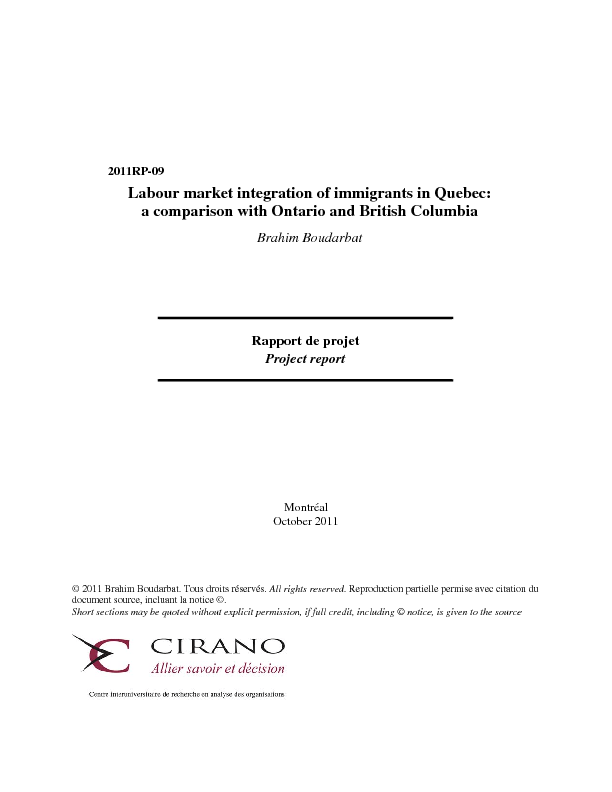Labour market integration of immigrants in Quebec: a comparison with Ontario and British Columbia
The economic turmoil of recent years has had a greater impact on immigrants than on the Canadian born: Nation-wide, between 2008 and 2010 the unemployment rate of the former increased by 2.7 percentage points and that of the latter by 1.7 points. This deterioration is observed in all three of the provinces we examinedespecially in British Columbia, where the unemployment rate of immigrants rose by 3.9 percentage points between 2008 and 2010. In Ontario, the unemployment rate of immigrants increased by 2.8 percentage points during the same period, versus only 1.2 percentage points in Quebec.
The unemployment rate differential between immigrants to Quebec and British Columbia shrank dramatically between 2006 and 2010, from 7.9 to 3.6 percentage points. This trend is the result of a marked deterioration in the situation of immigrants on the B. C. labour market.
With regard to the unemployment rate of those born in Canada, the situation in Quebec is comparable to that in British Columbia and better than in Ontario. Quebec also resembles other Canadian provinces how well it integrates immigrants having completed their postsecondary studies in Canada. However, this province is distinguished by an unemployment rate that is much higher for immigrants who obtained their postsecondary education abroad (13 %) than for those who acquired it here (7.8 %). In the two other provinces, the country in which the credentials were awarded weighs relatively less in the hiring decision: The unemployment rate for immigrants with foreign postsecondary credentials was 9.7 % in Ontario and 7.6 % in British Columbia in 2010.
Rapid integration of newcomers poses another challenge for Quebec. In 2010, the unemployment rate of immigrants having been in Canada five years or less was 19.4 % in Quebec, compared to 17.9 % in Ontario and 13.8 % in British Columbia.
Another specificity of Quebec's labour market is that it is less accessible to poorly educated immigrants: In 2010, the unemployment rate in Quebec of those with no degree, certificate or diploma was 20.5 %, in contrast to 15.8 % in British Columbia and 17.9 % in Ontario. On the other hand, the unemployment rate of immigrants with a university degree was 9.4 % in Quebec, 9.0 % in Ontario, and 8.0 % in British Columbia. Thus, integration into the labour market in Quebec and elsewhere does not only reflect recognition of foreign degrees, since those who don't have one typically encounter more problems finding work than others.
Despite these difficulties integrating into the Quebec labour market, the percentage of immigrants who report having experienced problems or difficulties in finding work during their first four years in Canada is relatively lower in Quebec (63.8 %) than in Ontario (71.0 %) and British Columbia (65.1 %).
According to the immigrants themselves, the lack of Canadian experience is the greatest hurdle to finding work (71.8 % in Quebec, 74.4 % in Ontario, and 64.1 % in British Columbia). This suggests that access to a first suitable job is crucial to the integration of immigrants. The second obstacle to obtaining a job involves language skills: 49.7 % of new immigrants to Quebec identified this as a problem, compared with 42.3 % in Ontario and 48.5 % in British Columbia. Thus, there is a case to be made for strengthening programs that help immigrants master the language used in the labour market of the host country.
Whether well founded or not, the perception of discriminatory hiring practices is evoked by very few immigrants, but the proportion of those who do mention this is slightly higher in Quebec (21.8 %) than in Ontario (17.1 %) or British Columbia (12 %). These values fall to 7.4 %, 3.2 %, and 3.1 %, respectively, when only the main obstacles to employment are considered. It is in Quebec that the rate of overqualification of Canadian-born university graduates is lowest, at 34.9 % in 2010, versus 42.7 % in British Columbia and 40.1 % in Ontario. Immigrants to Quebec with a degree from a Canadian university also benefit from this comparative advantage, since their rate of overqualification (43.6 %) is lower than that of immigrants to British Columbia (47.9 %). As to immigrants with a university degree earned abroad, in Quebec 64.9 % of them are overqualified for their job, compared with 64.6 % in Ontario and 70.2 % in British Columbia. Thus, immigrants in this latter province are more successful in finding work than their counterparts in Quebec, but their jobs are less likely to match their skills. Overall, Canadian-born workers are more likely than immigrants to be employed in the public sector and in union shops. However, between 2006 and 2010 we observe an improvement in these indicators among immigrants. Quebec's public sector has the best record for employing immigrants. In 2010, 16.5 % of immigrants with a job in Quebec were employed by this sector, versus 14.9 % in Ontario and 14.8 % in British Columbia. Since 2006, the public sector's share in the employment of immigrants has increased by three percentage points in Quebec, compared to less than two points in the other two provinces. Consequently, the record of the Government of Quebec and its agencies cannot be faulted in the matter of the recruitment of immigrants.
Immigrants increasingly opt for self-employmentand do so in a greater proportion than native-born Canadians. British Columbia is the province in which this form of employment is most widespread among immigrants (21.4 % in 2010). In Quebec, 18.7 % of immigrants created their own jobs (17.1 % in Ontario). This is a marked increase over 2006, when it was only 16.9 % (15.8 % in Ontario and 21.8 % in British Columbia). Promoting private initiative could play a central role in programs to foster integration into the labour market.
As is the case for those born in Canada, the rate of unionization is considerably higher among immigrants in Quebec (32 % in 2010) than in Ontario (24.7 %) and British Columbia (28.3 %), and this rate is rising steadily (30.4 % in Quebec in 2006).
The percentage of immigrants with a permanent job in 2010 was relatively lower in Quebec (84.9 %) than in Ontario (88.1 %) and British Columbia (89.1 %). The proportion of full-time jobs held by immigrants was 83.6 % in Quebec and 84.9 % in Ontario, versus only 80.7 % in British Columbia. With regard to wages, for each dollar earned by those born in Canada in 2010, immigrants earned $0.93 in Quebec and British Columbia and $0.95 in Ontario, on average. These earnings differentials do not account for differences between the characteristics of immigrants and those born in Canada.
Multivariate analysis reveals that the observable characteristics of immigrants to Quebec fall far short of explaining the gaps that exist between them and immigrants to Ontario and British Columbia in terms of the unemployment rate. For example, the gap between the unemployment rate of immigrants to Quebec and to British Columbia during the 20062010 period would only have fallen by one-fifth had the two provinces received the same type of immigrants. The Quebec-Ontario differential would have been cut by one-third. Consequently, immigrants to Quebec must contend with a labour market that appears inherently less open to hiring them. This situation may be attributed to a reluctance among Quebec employers to recruit immigrants. It is also possible that immigrants to Quebec are less likely to revise downward their expectations in order to adapt to market realities. So, they may refuse taking available jobs that do not match their expectations, and by doing so, they may risk a long spell of unemployment.
Notwithstanding the problems with integration detailed in this report, immigration remains a positive contribution: Overall, 87.6 % of immigrants aged 15 to 64 who are on the labour market90.6 % of those with a university degreehave a job and are contributing to the socio-economic development of Quebec.
Immigration certainly plays an important role in boosting demographic growth and providing manpower to the labour market. However, it should not detract from the importance of other policies that affect the size and skill level of the labour force in the short and long term. The government should continue to promote investment in Quebec's school system, persist in combating dropping out school, and strengthen incentives to families to boost the birthrate.




